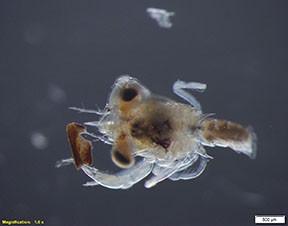Check out the new video about our blue crab research: https://www.youtube.com/watch?v=bQT1ihMoEak
Background: The Texas State aquarium provided funding to UTMSI for a citizen science project that will provide insight into the causes of declining blue crab populations in South Texas. Blue crabs support a $12 million dollar commercial fishing industry and are the primary food source for many beloved species, such as the endangered Whooping Crane and red drum. Blue crabs have a complex life cycle and move between the ocean and bay systems. Scientists at UTMSI, led by Dr. Ed Buskey, are interested in better understanding this complexity and what makes the crabs move and migrate. Adult female crabs move from the bays to the open Gulf with large clusters of eggs under their bodies. These eggs hatch into tiny crab larvae that drift with the currents along the coast. When they encounter the passes between the bay and the Gulf, they sense the changes in salinity and chemicals in the water from the bays and wait for incoming tides to sweep them into the bays. While in the bays, the small crab larvae encounter sea grasses and other plants on the bottom which they attach to, and grow into juvenile crabs.
In order to figure out when and where the small crab larvae are moving, scientists put fuzzy traps made with a material similar to air conditioning filter in different parts of our local bays. The fuzzy surface of the traps provide the perfect location for a larval crab to settle and cling to. Volunteers pull up these traps each day, wash off the crab larvae and preserve them so scientists can identify and count them. This allows scientists to know how many blue crab larvae are making their way back into the bay from the Gulf of Mexico. Because of the limited number of local passes between the bays and the Gulf, scientists think that blue crab populations could be declining because there are not enough larval crabs finding their way back into our bays. For example, the reopening of Cedar Bayou will allow more larval blue crabs to enter Mesquite Bay near the Aransas National Wildlife Refuge. This should help increase the populations of blue crabs near the refuge, which are an essential winter food for Whooping Cranes.
This project is a component of the Mission-Aransas Reserve, which is managed by the University of Texas Marine Science Institute and supported by the National Oceanic Administration.









